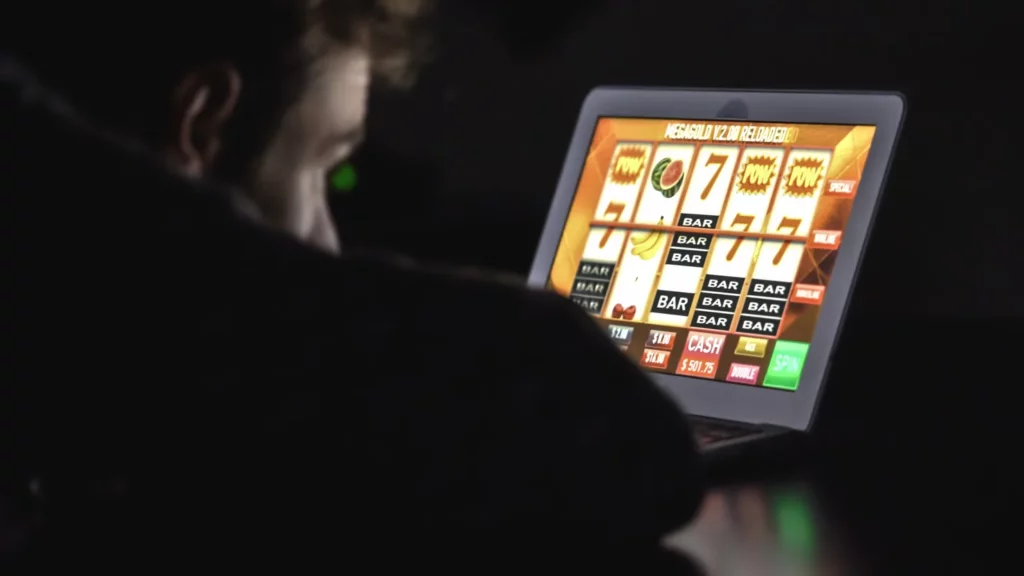Picture this—1998, a dingy college dorm, and a roommate with a gleam in his eye like he just discovered buried treasure. “Dude, check this out,” he says, dragging me over to his massive CRT monitor (you know, the kind that took up half the desk). On the screen? A janky little poker site where real money was being thrown around like it was Monopoly cash.
The graphics? Absolute garbage—pixelated cards that lagged mid-deal, making every hand feel like a slow-motion robbery. But the concept? Revolutionary.
We sat there, mesmerized, watching people from Australia, Europe, and every corner of the U.S. playing hands at ungodly hours. All connected by the magic of dial-up modems and a shared addiction to this new, unregulated frontier.
The idea that you could sit in your dorm room, beer in hand, and take some guy’s paycheck from halfway across the world? Mind-blowing.
Online gambling wasn’t just some fluke—it was a product of the internet’s wild expansion in the ‘90s. In 1994, Antigua and Barbuda (not exactly Vegas, but hey) passed the Free Trade & Processing Act, basically saying, “Come start your online casino here, no questions asked.” And that’s all it took. By 1996, InterCasino was up and running, and suddenly, the digital Wild West was open for business.
Casinos popped up left and right, running out of places like Costa Rica, the Isle of Man, and—you guessed it—Antigua. Why? Because nobody was watching. Unlike Vegas or Atlantic City, where regulators were breathing down casino owners’ necks, online gambling operated in a legal twilight zone. No rules, no oversight—just pure, uncut opportunity.
Now, before you get all nostalgic, let’s be honest—the tech sucked. Software crashes, disconnections, and UIs that looked like they were designed by someone’s nephew on Windows 95. Every early online gambler knew the gut-wrenching horror of getting disconnected mid-hand, only to log back in and see your pocket aces folded into oblivion.
And trust? Forget about it. Scammers ran wild. Some sites were rigged, some just vanished overnight, taking every player’s bankroll with them. But the lure of easy access—being able to fire up a game in your pyjamas, no sketchy casino trips required—was too good to resist. And people kept coming.
Some players even ended up borrowing money or gambling on credit just to keep chasing wins.
Games like blackjack surged in popularity online, with players exploring different blackjack strategies and side bets right from their couch.
Looking back, those early days of online gambling were a perfect snapshot of the internet’s wild adolescence—reckless, lawless, and dripping with potential. Some struck gold. Others got cleaned out. But one thing’s for sure: it was a time of pure, unfiltered innovation, when the rules weren’t just being bent—they were being written in real-time.
And for those of us who were there? Well, we’ve got stories to tell.

Technological Advancements in Online Casinos
If you trace the history of online gambling, you pretty much get a highlight reel of internet evolution itself—crashes, breakthroughs, and the occasional moment of What were we thinking? Those early poker sites I cut my teeth on? Picture stiff, cartoonish avatars, laggy connections, and the ever-present threat of a mid-hand freeze that left you screaming at your dial-up modem. But as the internet leveled up, so did the gambling platforms, morphing from clunky digital backrooms into slick, high-speed arenas of pure action.
I still remember my personal game-changer—ditching dial-up for a cable connection in 2002. Suddenly, everything moved at lightspeed. Games loaded faster, animations smoothed out, and—most importantly—multi-tabling became possible.
One weekend, in an act of sheer ambition (or insanity), I split my screen four ways: juggling poker tournaments, live betting on European football, and trying not to spill my coffee. A few years earlier, just opening two tables felt like a high-risk maneuver.
Then came Flash technology, and with it, a whole new level of immersion. No more stiff, lifeless games—now, slots had storylines, bonus rounds, and progressive jackpots that ballooned into millions. Suddenly, online casinos weren’t just mimicking the real deal; they were enhancing it. And right when people started saying, Yeah, but it’s not the same as a real casino, live dealer games showed up.
The first time I saw an actual dealer in a Costa Rican studio spinning a roulette wheel while players chatted in real time? Mind blown. Sure, the video was grainy, and buffering mid-spin made you question your life choices, but the trust factor skyrocketed. Now, you weren’t just watching an algorithm—you were watching real cards hit the felt.
Of course, none of this mattered if you couldn’t move your money efficiently. In the early days, funding an account meant wire transfers, mailed checks, or sending your prayers into the void while your deposit processed at the speed of government paperwork. Enter e-wallets like Neteller and FirePay, which finally let players move money in and out instantly. This revolution was so game-changing that when the U.S. cracked down on online gambling in 2006, payment processors were among the first casualties.
Security? Let’s just say it was… an afterthought. In 2004, I shared a poker account with two friends, using a password so weak it might as well have been “password123.” We weren’t alone—early encryption was flimsy, and account security was a joke.
But as hacks and identity theft ramped up, gambling sites had no choice but to step up their game, rolling out two-factor authentication, stronger encryption, and fraud detection that actually worked. But even today, some players still wonder how fair these games are and if casinos can control slot machine results and payouts when everything is digital.
Then, just when things felt settled, mobile gambling arrived. The first mobile apps were clunky Java-based relics, barely functional and definitely not optimized for fat thumbs. But they set the stage for what would become the dominant force in online gambling once smartphones took over. Suddenly, players didn’t need a desktop setup or even a laptop—they could bet, bluff, and spin from anywhere, anytime.
Each wave of tech didn’t just change online gambling—it reshaped the entire experience, making it faster, more secure, and (let’s be honest) more addictive.
What started as a niche internet curiosity has become a full-blown digital ecosystem, where high-speed connections, cutting-edge graphics, and AI-powered security are the norm. And if history tells us anything, the next evolution is probably already in the works—whether we’re ready for it or not.
The Wild Ride of Online Gambling Regulation: From Free-for-All to Fine Print
If online gambling regulation were a poker hand, the early years were an all-in bluff—no oversight, no restrictions, just pure chaos. But as governments caught on, they scrambled to build a rulebook after the game had already started. What followed was a regulatory rollercoaster that reshaped the industry, sometimes in predictable ways and other times with WTF just happened? moments.
The Free-for-All Era (1996–2000): Gamble First, Ask Questions Later
- Online gambling existed in a legal gray area—laws hadn’t caught up with the internet.
- Early sites accepted players from anywhere and everywhere, creating a borderless digital casino.
- I once played poker in 1999 with opponents from at least 30 different countries—a virtual Wild West with real money at stake.
Early Attempts at Control (2001–2005): Governments Take a Stab at Regulation
- Australia’s 2001 Interactive Gambling Act: Instead of embracing online gambling, they banned it for residents while allowing offshore operators to thrive (brilliant strategy, right?).
- UK’s 2005 Gambling Act: The UK took a smarter approach—regulation instead of prohibition. The newly formed UK Gambling Commission required:
- Player identity verification
- Responsible gambling protocols
- Segregated player funds (translation: your money was finally safe-ish)
- This UK model set the gold standard for future regulations.
The UIGEA Disaster (2006): The U.S. Drops the Hammer
- The Unlawful Internet Gambling Enforcement Act (UIGEA) didn’t technically outlaw online gambling—it just made processing payments illegal.
- The industry went into full panic mode. Stocks crashed, and big operators like PartyPoker bailed overnight, blocking all U.S. players.
- The result? Shady offshore sites filled the gap, using sketchy payment processors. Depositing became a game of “guess what category my transaction will be disguised as today.”
2010s: A Patchwork of Rules and Workarounds
- By now, countries fell into three categories:
- Total bans (China, Singapore)
- Regulated markets (UK, Italy, France)
- Gray areas (ahem Canada, much of Latin America)
- The U.S. started reversing course in 2011 with a reinterpretation of the Wire Act, allowing states to regulate online gambling.
- Nevada, New Jersey, and Delaware were first, launching legal online poker and casino games.
- In 2013, I actually drove to New Jersey just to play on a regulated poker site—a hilarious twist given that I used to play from home with zero restrictions.
Modern Era: Regulation Becomes the Norm (Sort Of)
- The EU tried (and mostly failed) to create uniform gambling regulations across member states.
- The U.S. expanded, with more states legalizing online gambling—but still no federal framework.
- Geolocation verification became standard—meaning if you weren’t physically in a legal state or country, tough luck.
- Terms like KYC (Know Your Customer) became everyday lingo, making anonymous play a relic of the past.
The Big Picture: A New Game with New Rules
The online gambling world transformed from a digital free-for-all into an industry full of licensing, oversight, and fine print. Whether that’s a good thing depends on who you ask—some players miss the Wild West days, while others appreciate the added security and fairness. But one thing’s for sure: just like a good poker game, the rules will keep evolving, and the smartest players will be the ones who adapt.
From Chips to Clicks: How Online Gambling Forced Casinos to Adapt

The rise of online gambling didn’t just ruffle a few feathers—it sent shockwaves through the entire casino industry. Suddenly, those grand, neon-lit gambling palaces had a new competitor, one that didn’t need a multimillion-dollar lobby, cocktail waitresses, or a buffet line. By the early 2000s, brick-and-mortar casinos were feeling the pressure, though at first, they refused to take the threat seriously.
I remember walking into a Las Vegas casino in 2003 and noticing something different. The energy was still there, but you could sense an underlying anxiety. Operators were scrambling to adapt—some doubling down on the classic casino experience, others hedging their bets by introducing celebrity chef restaurants, luxury accommodations, and high-end entertainment.
This shift wasn’t just about keeping up with changing tastes; it was about offering something online gambling couldn’t replicate.
The Denial Phase: “People Will Always Want the Real Thing”
In the early days, the traditional casino industry dismissed online gambling as a novelty. I once spoke to a veteran pit boss at Bellagio who scoffed at the idea that online poker could ever rival the real thing. He was certain people would always prefer the authentic experience. Then I casually mentioned that I had played more hands online in the past month than he had dealt in his entire career. He wasn’t laughing after that.
As the 2000s progressed, casino floors started showing gaps—fewer casual players at the lower-stakes tables, more empty seats where there had once been a steady hum of activity. The younger generation, raised in a digital world, found it easier (and far less intimidating) to gamble online, where they could play lower stakes, skip the dress code, and avoid awkward conversations with a dealer.
From Competition to Integration: Casinos Fight Back
By 2008–2010, physical casinos realized they couldn’t just ignore online gambling—they had to find a way to coexist. Some of the biggest names in the industry, like Caesars Entertainment and MGM, started investing in online gaming technology, while tribal casinos pushed for legislation allowing them to launch online platforms.
I saw this shift firsthand in 2012 at MGM Grand, where they had rolled out a loyalty program that linked online and in-person play. A casino host explained that customers who engaged with MGM’s online platform actually visited the physical property more often, not less. This blew up the old assumption that online gambling was purely a threat—turns out, it could be a powerful marketing tool.
The 2008 Recession & Casino Closures
The financial crisis hit casinos hard, forcing them to rethink everything. Unlike online platforms, which could operate lean, physical casinos had massive overhead costs—buildings, employees, regulatory compliance. Several major casino companies filed for bankruptcy, and regional casinos were hit the hardest. Between 2014 and 2016, I watched multiple mid-sized casinos shut down permanently, unable to compete with the lower-cost, always-accessible digital alternatives.
Atlantic City was one of the most dramatic examples. It went from twelve casinos to just seven in a few years—a brutal correction that devastated local economies that relied on gambling revenue.
The COVID-19 Wake-Up Call
If there was any doubt about online gambling’s importance, the COVID-19 pandemic erased it overnight. When casinos were forced to close their doors, the ones with existing online platforms pivoted instantly. Those without? They scrambled to catch up.
The industry saw a decade’s worth of digital transformation compressed into a few months. Suddenly, even the most old-school casino executives realized that having an online presence wasn’t just an option—it was survival.
The New Casino Experience: Digital + Physical Synergy
Fast forward to today, and the most successful casinos have fully embraced the digital shift. Instead of seeing online gambling as the enemy, they’ve integrated it into their overall business strategy:
- Loyalty programs now span both digital and physical experiences.
- Casinos have repositioned themselves as entertainment hubs rather than just places to gamble.
- Regulated markets favor established operators, meaning that brick-and-mortar casinos now own a big slice of the online gambling pie.
The old fear that online gambling would kill traditional casinos turned out to be wrong—at least for those that adapted. Instead, we’re seeing a blended model, where digital and physical gambling reinforce each other. The casinos that survived this transformation didn’t just keep up with the game—they learned how to play a whole new one.
Conclusion: The Ongoing Evolution of Online Gambling
The trajectory of online gambling from its rudimentary beginnings to its current sophisticated state mirrors the broader evolution of the internet itself. What started in those unregulated days of the mid-1990s has matured into a multi-billion dollar industry that continues to transform before our eyes.
I’ve watched this evolution unfold from multiple vantage points—first as a curious college student placing small bets on primitive platforms, then as a more serious player navigating the complex regulatory changes, and now as someone who can appreciate the technological marvel that online gambling has become. Through each phase, the industry has demonstrated remarkable resilience and adaptability.
The regulatory landscape remains in flux, with countries constantly reassessing their approaches. Some nations that initially prohibited online gambling have moved toward regulation as they recognize the futility of enforcement and the potential tax revenue.
Others have tightened restrictions in response to growing concerns about problem gambling and money laundering. This regulatory dance will likely continue for decades, reflecting the inherent tension between personal freedom and social responsibility.
Technology continues driving innovation at a breathtaking pace. Virtual reality casinos now offer immersive experiences that would have seemed like science fiction during those early days. Cryptocurrency has introduced new payment methods and even new forms of gambling specific to blockchain technology.
Artificial intelligence has transformed everything from customer service to security protocols, making platforms simultaneously more accessible and secure than ever before- and harder for some people to keep their impulses in check.
Perhaps most fascinating is how online gambling has influenced broader social attitudes toward gambling itself. What was once a stigmatized activity confined to specific locations has become normalized and accessible from anywhere. Players started to form communities, share tips, celebrate wins (and losses), and even build a shared language of blackjack terms and craps slang.
This mainstreaming has both positive and negative implications—greater transparency and consumer protections on one hand, increased potential for problem gambling on the other.
Looking ahead, the boundaries between different forms of digital entertainment will continue to blur. We’re already seeing gambling mechanics incorporated into video games, social media platforms hosting poker applications, and sports betting integrated directly into broadcast experiences. The gambling industry has proven remarkably adept at identifying new channels and adapting its offerings accordingly.
For all the technological and regulatory changes, what remains constant is the fundamental human attraction to risk and reward. Whether playing on a cutting-edge VR platform or sitting at a physical poker table, gamblers are still chasing that perfect balance of skill, chance, and the possibility of a significant payout.
The platforms and regulations will continue evolving, but this essential experience remains at the core of gambling’s enduring appeal.
My own relationship with online gambling has evolved alongside the industry itself—from novelty to hobby to occasional diversion. I’ve learned to appreciate not just the games themselves but the remarkable complex ecosystem that’s developed around them.
Whatever form online gambling takes in the future, its journey from those primitive early sites to today’s sophisticated platforms represents one of the most fascinating case studies in how technology transforms human experiences—sometimes in ways we can predict, but often in ways we never imagined possible.

